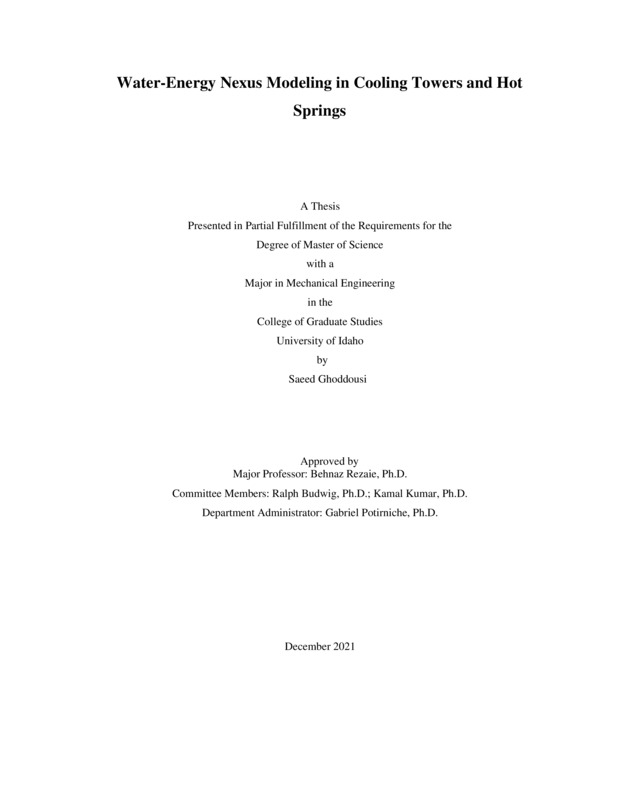Water-Energy Nexus Modeling in Cooling Towers and Hot Springs
Ghoddousi, Saeed. (2021-12). Water-Energy Nexus Modeling in Cooling Towers and Hot Springs. Theses and Dissertations Collection, University of Idaho Library Digital Collections. https://www.lib.uidaho.edu/digital/etd/items/ghoddousi_idaho_0089n_12276.html
- Title:
- Water-Energy Nexus Modeling in Cooling Towers and Hot Springs
- Author:
- Ghoddousi, Saeed
- Date:
- 2021-12
- Keywords:
- Cooling Tower Energy Conservation Hot Spring Water Conservation Water-Energy Nexus
- Program:
- Mechanical Engineering
- Subject Category:
- Mechanical engineering
- Abstract:
-
Water and energy resources are essential to humanity’s existence which have shaped society's development. The limited water and energy resource forced humans to seek new ways to use them more efficiently. The recent increase in water and energy demand makes any water and energy conservation effort very valuable. In the absence of conservation efforts, providing sufficient supplies of these resources may not be applicable in the future. The present thesis found two applications for implementing a more efficient approach to their operation for water and energy conservation purposes.Cooling towers are equipment for dissipating the excess heat by water evaporation. The study elaborates on the role of cooling tower modeling in implementing any water and energy consumption improvement plan by presenting a modeling approach, categorizing various methods of modifying water and energy consumptions through past studies. To map the future studies, summarize and organize the past efforts and find future research trends for upgrading water and energy usage in cooling towers have been done. The practical approaches to save water and energy such as design cooling tower based on the ambient air conditions, add dry section to existed wet cooling tower, and employ variable frequency drive fans in forced draft cooling tower have been proposed. An improvement plan has been implemented on the existed mechanical draft wet cooling tower located at the main campus of University of Idaho by using Data Acquisition Device (DAQ) and ambient air condition real data. By adjusting outlet water temperature in the cooling tower developed model, the cooling towers load can be managed, which reduces its water and energy consumption. Consequently, the improvement plan reduced cooling tower fans energy consumption and water loss due to evaporation. For one month of operation of the improved plan, up to 28035.50 kWh energy saving, 179.49 m3 of water saving, and $1125.17 cost savings have been recorded. The present thesis found low-temperature geothermal energy sources such as hot springs distributed in different areas as a potential for implementing small-scale energy plants for indirect energy usage. A techno-enviro-economical tool has been developed to approximate the technical, economic, and environmental aspects of hot spring power plant projects, including power generation capacity, initial investment, and possible income from the power plant. The developed technical model estimated the hot springs power generation plants from 9.3 kW to 303 kW depending on the temperature and water discharge mass flow rate. The developed economic model calculated the payback period of investing in a hot spring energy plant as low as six years, which is better cost-effective than other geothermal energy plants.
- Description:
- masters, M.S., Mechanical Engineering -- University of Idaho - College of Graduate Studies, 2021-12
- Major Professor:
- Rezaie, Behnaz
- Committee:
- Budwig, Ralph; Kumar, Kamal; Potirniche, Gabriel
- Defense Date:
- 2021-12
- Identifier:
- Ghoddousi_idaho_0089N_12276
- Type:
- Text
- Format Original:
- Format:
- application/pdf
- Rights:
- In Copyright - Educational Use Permitted. For more information, please contact University of Idaho Library Special Collections and Archives Department at libspec@uidaho.edu.
- Standardized Rights:
- http://rightsstatements.org/vocab/InC-EDU/1.0/

